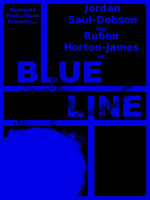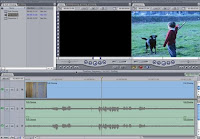W1 Group 1 2011
Thursday, 5 May 2011
Monday, 2 May 2011
Poster for advertising BlueLine
 This poster was designed and created to advertise "BlueLine" to our primary audience. It was created using "Gimp" photo editing software at one of the group members houses. We picked the blue-black colour scheme for various reasons. Firstly, because the film is called "BlueLine" and so we thought blue would be appropriate, secondly because the black represents mystery, or something sinister. Also the "blood drop" shadow behind the text could reinforce the sinister effect. The four lines, one below "blue" and "line", and then others protruding from the words themselves, are symbolic of the train track that he travels down on his final journey out of his old life to start his new one, which is where the film would continue if it had been made into a feature-length film. The large blue "blood drop" effect, was to reinforce the fainter ones and give a bigger impact on the audience.
This poster was designed and created to advertise "BlueLine" to our primary audience. It was created using "Gimp" photo editing software at one of the group members houses. We picked the blue-black colour scheme for various reasons. Firstly, because the film is called "BlueLine" and so we thought blue would be appropriate, secondly because the black represents mystery, or something sinister. Also the "blood drop" shadow behind the text could reinforce the sinister effect. The four lines, one below "blue" and "line", and then others protruding from the words themselves, are symbolic of the train track that he travels down on his final journey out of his old life to start his new one, which is where the film would continue if it had been made into a feature-length film. The large blue "blood drop" effect, was to reinforce the fainter ones and give a bigger impact on the audience.Tuesday, 19 April 2011
Sunday, 17 April 2011
Looking back at the preliminary task, what do you think you have learnt from the progression from it to the full task?
Our preliminary task involved shooting one of the group members walking down the staircase in Loreto and then proceeding to the canteen. Altogether there were 16 shots; a mixture of long shots and close-ups. Some of the techniques that were used in the preliminary task, such as jump cuts, were abandoned in the main task as they did not fit our genre. However, a technique we did re-use was a match cut, and in both cases it was the protagonists feet that we used to achieve the match cut. In the main task, the match cut came when our main character was walking down the staircase inside his house.
When we filmed the preliminary, and even in the early stages of the main task, our positioning of shots did not look as professional as we hoped. We failed to manipulate mise en scene correctly to create the best possible shot. However, we believe our final piece shows good knowledge of how to properly position each shot to gain maximum effect. An example of this is the ‘hole in the door’ framed shot. We thought that this would make our character look isolated and alone. We also decided to recreate an entirely new soundtrack, replacing all original ambient sound captured when filming, with non-diegetic sound. This allowed greater control and a more creative choice for us to make in terms of the diegesis and also the quality of sound was improved. This meant that we had to source these sounds, put them as one track using Logic Pro (the timing was crucial!) as well as then dropping that onto the timeline on Final Cut Pro.
What have you learnt about technologies from the process of constructing this product?
Considering our general lack of experience with filming, we were very pleased with the way some of our shots worked. For example, the scene at Deansgate railway station was quite difficult because we had to shoot moving objects and because members of the public became involved in the shots.
One memb
 er of our group was very good at editing due to his prior work experience at the BBC where he had already used Final Cut Pro. He was therefore familiar with effects such as Light Rays (which we then used for our flashback). We all learned alot about the principle of dropping images and sound onto the time line and synchronising them.
er of our group was very good at editing due to his prior work experience at the BBC where he had already used Final Cut Pro. He was therefore familiar with effects such as Light Rays (which we then used for our flashback). We all learned alot about the principle of dropping images and sound onto the time line and synchronising them.


